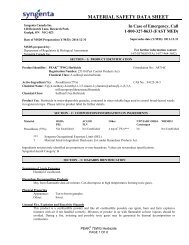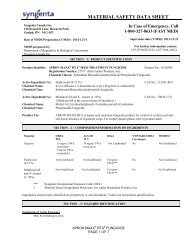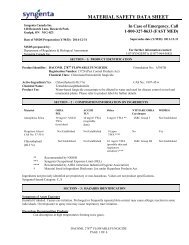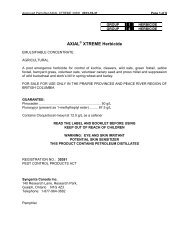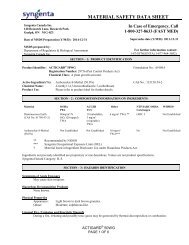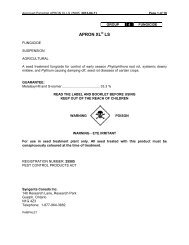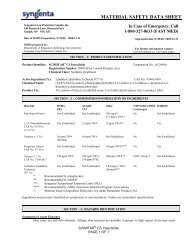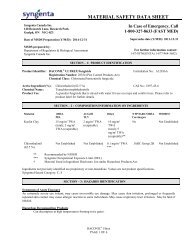REGLONE DESICCANT - Syngenta Crop Protection
REGLONE DESICCANT - Syngenta Crop Protection
REGLONE DESICCANT - Syngenta Crop Protection
Create successful ePaper yourself
Turn your PDF publications into a flip-book with our unique Google optimized e-Paper software.
Approved Pamphlet <strong>REGLONE</strong> Desiccant 26396 2015-01-16 Page 1 of 20GROUP 22 HERBICIDESolutionAGRICULTURAL<strong>REGLONE</strong> ® <strong>DESICCANT</strong>For Potato Vine Killing, Desiccation of Pulse, Oilseed and Legume Forage Seed <strong>Crop</strong>s, WeedControl in Vegetable and Field <strong>Crop</strong>s, Control of Corn Spurry in Oats and Weed Control in NoncropLand (rights-of-way for transportation or utility corridors, airports, wasteland, garbagedumps and industrial parks).GUARANTEE:Diquat ion ........................................................ 240 g per litre(Present as dibromide)READ THE LABEL AND BOOKLET BEFORE USINGKEEP OUT OF REACH OF CHILDRENWARNINGPOISONCAUTION – EYE AND SKIN IRRITANTREGISTRATION NO. 26396PEST CONTROL PRODUCTS ACT<strong>Syngenta</strong> Canada Inc.140 Research Lane, Research ParkGuelph, OntarioN1G 4Z3Telephone: 1-877-964-3682
Approved Pamphlet <strong>REGLONE</strong> Desiccant 26396 2015-01-16 Page 2 of 20NOTICE TO USERWARNING!*HARMFUL OR FATAL IF SWALLOWED.HARMFUL IF INHALED, AVOID INHALING/BREATHING DUST,SPRAYS, ETC.*CAUSES SUBSTANTIAL, BUT TEMPORARY, EYE INJURY.*DO NOT GET IN EYES, SKIN OR ON CLOTHING.*NEVER TRANSFER TO OTHER CONTAINERS.* KEEP OUT OF REACH OF CHILDREN AND ANIMALS.MAY IRRITATE THE SKIN, AVOID CONTACT WITH SKIN.This pest control product is to be used only in accordance with the directions on the label. It is anoffence under the Pest Control Products Act to use this product in a way that is inconsistent with thedirections on the label. The user assumes the risk to persons or property that arises from any suchuse of this product.FIRST AIDTake container, label or product name and Pest Control Product Registration Number with you whenseeking medical attention.If swallowed, call a poison control centre or doctor IMMEDIATELY for treatment advice. Do notinduce vomiting unless told to do so by a poison control centre or doctor. Do not give anything bymouth to an unconscious person.If in eyes, hold eye open and rinse slowly and gently with water for 15–20 minutes. Remove contactlenses, if present, after the first 5 minutes, then continue rinsing eye. Call a poison control centre ordoctor for treatment advice.If on skin or clothing, take off contaminated clothing. Rinse skin IMMEDIATELY with plenty ofwater for 15–20 minutes. Call a poison control centre or doctor for treatment advice.If inhaled, move person to fresh air. If person is not breathing, call 911 or an ambulance, then giveartificial respiration, preferably by mouth-to-mouth, if possible. Call a poison control centre or doctorfor further treatment advice.TOXICOLOGICAL INFORMATIONTo be effective, treatment for ingestion of the product must begin IMMEDIATELY. Ifswallowed, give stomach a wash-out and test urine and gastric aspirate for diquat. If positive, giveup to 1 litre of adsorbent suspension (e.g., activated charcoal, bentonite clay, etc.) mixed with apurgative (MgSO 4 , Na 2 SO 4 or mannitol). Repeat administration of adsorbent suspension every 2 hrsfor first 24 hrs and every 4 hrs for the next 24 hrs, plus purgatives as required. Maintain and monitorelectrolyte and fluid status daily. Consider haemodialysis or haemoperfusion using charcoalcolumn.
Approved Pamphlet <strong>REGLONE</strong> Desiccant 26396 2015-01-16 Page 3 of 20If in eyes, treat symptomatically, using antibiotics and steroids as necessary.PRECAUTIONSEXCESSIVE EXPOSURE TO DIQUAT MAY CAUSE A HEALTH HAZARD. FOLLOWING THEDIRECTIONS AND PRECAUTIONS WILL REDUCE EXPOSURE.Wear coveralls over a long-sleeved shirt, long pants, chemical-resistant gloves and footwear,goggles and a respirator during mixing/loading and application, chemical-resistant headgear foroverhead applications and a chemical-resistant apron when cleaning equipment, mixing/loading.Most exposure to pesticides is by absorption through skin, especially from concentrated materialhandled at the time of mixing and loading. Since most of this exposure is on the hands andforearms, use of long-sleeve chemical resistant water proof gloves will reduce exposuresubstantially. Rolling down the sleeve end of the glove will prevent drips of liquid from running downthe glove onto your arm.If concentrate splashes onto the side of the spray tank, and you subsequently lean against the tank,the clothing and skin over the abdomen will be exposed to <strong>REGLONE</strong> ® Desiccant concentrate. Useof a chemical resistant apron will reduce this likelihood. Users should remove personal protectiveequipment immediately after handling this product. Wash the outside of the gloves before removing.As soon as possible, wash thoroughly and change into clean clothing. Users should remove clothingimmediately if pesticide comes in contact with skin through soaked clothing or spills. Then wash skinthoroughly and put on clean clothing. If clothing has been contaminated, remove it and launder it assoon as possible. Do not leave wet contaminated clothing in contact with skin for extended periods.Wash clothing in detergent and hot water before reuse. <strong>REGLONE</strong> Desiccant is irritating to eyes.Always use chemical resistant goggles and/or a face shield. AVOID WORKING IN SPRAY MIST.Do not eat, drink, handle or use tobacco, or apply cosmetics in areas where there is potential forexposure to this product. Users should wash hands and face before eating, drinking, chewing gum,handling tobacco or using the toilet. Store and wash all protective clothing separately from householdlaundry.Do not contaminate food, feed, domestic or irrigation water supplies, lakes, streams and ponds.DO NOT enter or allow worker entry into treated areas during the restricted-entry interval (REI) of 24hours for all agricultural uses. For all other terrestrial uses, DO NOT enter or allow worker entry intotreated areas during the restricted-entry interval of 12 hours.STORE IN ORIGINAL CONTAINER tightly closed in a safe place away from children.If this pest control product is to be used on a commodity that may be exported to other countries inthe world and you require information on acceptable residue levels in these countries, pleasecontact <strong>Syngenta</strong> Canada Inc. at 1-87-SYNGENTA / 1-877-964-3682.ENVIRONMENTAL HAZARDSANY DRIFT OF THIS PRODUCT OUTSIDE THE IMMEDIATE FIELD AREA MAY RESULT INDAMAGE TO CROPS, SHELTERBELTS, ORNAMENTAL PLANTS, LAWNS, GRAZING AREAS,WILDLIFE COVER, WETLANDS, AND OTHER DESIRABLE GROWTH.
Approved Pamphlet <strong>REGLONE</strong> Desiccant 26396 2015-01-16 Page 4 of 20TOXIC to aquatic organisms and non-target terrestrial plants. Observe buffer zones specifiedunder DIRECTIONS FOR USE.To reduce runoff from treated areas into aquatic habitats avoid applications to areas with amoderate to steep slope, compacted soil, or clay.Avoid application when heavy rain is forecast.Contamination of aquatic areas as a result of runoff may be reduced by including a vegetative bufferstrop between the treated area and the edge of the water body.STORAGEStore in original container, tightly closed, in a safe place away from children.Store above 0 o C. If crystallization occurs because of storage below this, warm to room temperatureand agitate gently until reconstituted.To prevent contamination store this product away from food or feed.DECONTAMINATION AND DISPOSALFor information on disposal of unused, unwanted product, contact the manufacturer or the provincialregulatory agency. Contact the manufacturer and the provincial regulatory agency in case of a spill,and for clean up of spills.CONTAINER DISPOSAL:FOR DISPOSAL OF PLASTIC JUGS:Do not reuse this container for any purpose. This is a recyclable container, and is to be disposed ofat a container collection site. Contact your local distributor/dealer or municipality for the location ofthe nearest collection site. Before taking the container to the collection site:1. Triple- or pressure-rinse the empty container. Add the rinsings to the spray mixture in thetank.2. Make the empty, rinsed container unsuitable for further use.If there is no container collection site in your area, dispose of the container in accordance withprovincial requirements.FOR REFILLABLE CONTAINERS:For disposal, this container may be returned to the point of purchase (distributor/dealer). It must berefilled by the distributor/dealer with the same product. Do not reuse this container for any otherpurpose.IN CASE OF EMERGENCY INVOLVING A MAJOR SPILL, FIRE OR POISONING,CALL 1-800-327-8633 (FASTMED)
Approved Pamphlet <strong>REGLONE</strong> Desiccant 26396 2015-01-16 Page 5 of 20PRODUCT INFORMATION<strong>REGLONE</strong> Desiccant is a non-volatile, fast acting herbicide. It is inactivated on contact with the soiland therefore, has no residual effect. The herbicidal effect varies with weed species, hence repeatapplications may be necessary upon certain perennial weeds. Annual weeds are generally killedwith one application.Germination of seed is not affected by <strong>REGLONE</strong> Desiccant for all crops which could go for seedsale.<strong>REGLONE</strong> Desiccant is easily applied in high or low volume sprayers. Very low volume or ultra lowvolume equipment for aerial application, e.g. rotary atomizer nozzles such as MICRONAIR, are notrecommended. Flat fan or hollow cone nozzles are recommended for optimum results. Always userecommended water volume. Complete coverage is essential. DO NOT USE MIST BLOWERS.<strong>REGLONE</strong> Desiccant is rapidly absorbed by plants, and effectiveness is not reduced by rain fallingshortly after treatment. EFFECTIVENESS OF THE TREATMENT MAY BE ENHANCED WHENAPPLICATION IS MADE ON CLOUDY DAYS OR PRIOR TO PERIODS OF DARKNESS.Use clean (non-turbid) water for spraying <strong>REGLONE</strong> Desiccant. Muddy water will reduce theeffectiveness of <strong>REGLONE</strong> Desiccant.THE USER MUST BE AWARE THAT THIS PRODUCT ACCELERATES THE NATURALPROCESS OF CROP DRY DOWN. IN CASES OF ADVERSE WEATHER CONDITIONS SUCHAS HEAVY RAIN, HAIL OR STRONG WIND, THE RESULTANT DAMAGE TO YOUR CROP MAYBE ENHANCED. TAKE NOTE THAT CERTAIN CROPS ARE MORE FRAGILE THAN OTHERS.<strong>Crop</strong> waste remaining after harvest (e.g. pea vines, alfalfa stems) may be used as a feedsupplement for livestock.HARVESTINGThe use of <strong>REGLONE</strong> Desiccant facilitates direct combining of many field crops such as lentils,peas, canola, mustard or legumes. Growers who wish to swath desiccated crops should wait untilthe crop has dried down sufficiently to allow the desiccated crop to be picked up and threshedimmediately after swathing. Delaying threshing after swathing desiccated crops will increaseshattering and seed loss.For most crops, harvest can normally commence within 4-10 days after desiccation. However,adverse weather conditions such as rainfall, cool temperatures and high humidity will slow plantdesiccation and keep seed moisture levels high which can delay commencement of harvest beyond10 days after application. When those conditions prevail after <strong>REGLONE</strong> Desiccant desiccation,commence harvest when plant material is dry and seed moisture level allows efficient harvesting.To minimize seed loss and to maintain seed quality, harvest of desiccated crops should commenceas soon as seed moisture reaches the level for normal harvest.CLEANING SPRAYER AFTER USEIt is important to thoroughly wash equipment after spraying - use a wetting agent (AGRAL ® 90 at60 mL per 100 L of water), flush and spray out, then thoroughly rinse with clean water. When
Approved Pamphlet <strong>REGLONE</strong> Desiccant 26396 2015-01-16 Page 6 of 20possible, the equipment should be filled with clean water and left overnight. Spray out before storingequipment or using for other materials.DIRECTIONS FOR USEAs this product is not registered for the control of pests in aquatic systems, DO NOT use to controlaquatic pests.DO NOT contaminate irrigation or drinking water supplies or aquatic habitats by cleaning ofequipment or disposal of wastes.Refer to the following table for a summary of rates, application volumes and growth stages forground and aerial application of <strong>REGLONE</strong> Desiccant. The table provides operational information.The applicator is directed to the CROPS-ADDITIONAL NOTES section for any additionalinformation prior to spraying. Ground spraying may be done with any standard boom sprayer.When tank mixing, always read the labels of the tank mix partners and follow all directions for use,restrictions and precautions.Apply only when the potential for drift to areas of human habitation or areas of human activity suchas houses, cottages, schools and parks is minimal. Take into consideration meteorologicalconditions (e.g. wind speed, wind direction, temperature inversion) and application equipment andsprayer settings used for application.Mixers and loaders supporting aerial applications are required to use closed systems.Field sprayer application: DO NOT apply during period of dead calm. Avoid application of thisproduct when winds are gusty. DO NOT apply with spray droplets smaller than the American Societyof Agricultural Engineers (ASAE) medium classification. Boom height must be 60 cm or less abovethe crop or ground.Aerial application: DO NOT apply during periods of dead calm. Avoid application of this productwhen winds are gusty. Suggested conditions for good aerial application are moderatetemperatures (less than 25°C) and humidity (greater than 50%). DO NOT apply when wind speedis greater than 9 km/h at flying height at the site of application. DO NOT apply with spray dropletssmaller than the American Society of Agricultural Engineers (ASAE) medium classification. Tominimize spray drift, use flat fan or hollow cone nozzles, and a pressure of 150-200 kPa, with thenozzle pointed back 150°-180°. To reduce drift caused by turbulent wingtip vortices, the nozzledistribution along the spray boom length MUST NOT exceed 65% of the wingspan or rotorspan.For application to rights-of-way, buffer zones for production of sensitive terrestrial habitats are notrequired; however, the best available application strategies which minimize off-site drift, includingmeteorological conditions (e.g. wind direction, low wind speed) and spray equipment (e.g. coarsedroplet sizes, minimizing height above canopy), should be used. Applicators must, however, observethe specified buffer zones for protection of sensitive aquatic habitats.Use AGRAL 90, a wetting and spreading agent, at a rate of 1 L for each 1000 L of spray mixtureunless otherwise stated. For beans (white and red kidney, soybeans and adzuki beans) or lentils, LI700 ® at a rate of 2.5 L for each 1000 L of spray mixture may be used. See potato vine killing use fordetailed information on use of adjuvant on potatoes in the prairie provinces.
Approved Pamphlet <strong>REGLONE</strong> Desiccant 26396 2015-01-16 Page 7 of 20AGITATE WELL BEFORE USE.Buffer zones:The buffer zones specified in the table below are required between the point of direct applicationand the closest downwind edge of sensitive terrestrial habitats (such as grasslands, forested areas,shelter belts, woodlots, hedgerows, riparian areas and shrublands), sensitive freshwater habitats(such as lakes, rivers, sloughs, ponds, prairie potholes, creeks, marshes, streams, reservoirs andwetlands) and estuarine/marine habitats.Method ofApplicationField sprayer 1Aerial<strong>Crop</strong>Beans, canola, flax, lentils,mustard, peas, sunflower,legume forage seed crops, sweetwhite lupinsVegetable and field crops, fruit,non-cropland (including rights-ofway2 for transportation or utilitycorridors, airports, wasteland,garbage dumps and industrialparks), potatoesBeans, legumeforage seedcropsBuffer Zones (metres) Required for the<strong>Protection</strong> of:Aquatic Habitat of Depths: TerrestrialLess than 1mGreater than1 mHabitat5 3 310 5 5Fixed wing 150 80 90Rotary wing 100 55 70Potato Fixed wing 200 100 100Rotary wing 125 65 801 For field sprayer application, buffer zones can be reduced with the use of drift-reducing spray shields.When using a spray boom fitted with a shield (shroud, curtain) that extends to the crop canopy, thelabelled buffer zone can be reduced by 70%. When using a spray boom where individual nozzles are fittedwith cone-shaped shields that are no more than 30 cm above the crop canopy, the labelled buffer zonecan be reduced by 30%.2 For application to rights-of-way, buffer zones for protection of sensitive terrestrial habitats are notrequired.When a tank mixture is used, consult the labels of the tank-mix partners and observe the largest(most restrictive) buffer zones of the products involved in the tank mixture.GROUND APPLICATIONGround spraying may be done with any standard boom sprayer.
Approved Pamphlet <strong>REGLONE</strong> Desiccant 26396 2015-01-16 Page 8 of 20AERIAL APPLICATIONGeneric Aerial Application Label Instructions - Directions for UseApply only by fixed-wing or rotary aircraft equipment which has been functionally and operationallycalibrated for the atmospheric conditions of the area and the application rates and conditions of thislabel.Label rates, conditions and precautions are product specific. Read and understand the entire labelbefore opening this product. Apply only at the rate recommended for aerial application on this label.Where no rate for aerial application appears for the specific use, this product cannot be applied byany type of aerial equipment.Ensure uniform application. To avoid streaked, uneven or overlapped application, use appropriatemarking devices.Use PrecautionsApply only when meteorological conditions at the treatment site allow for complete and even cropcoverage. Apply only under conditions of good practice specific to aerial application as outlined inthe National Aerial Pesticide Application Manual, developed by the Federal/Provincial/TerritorialCommittee on Pest Management and Pesticides.Do not apply to any body of water. Avoid drifting of spray onto any body of water or other non-targetareas. Specified buffer zones should be observed.Coarse sprays are less likely to drift, therefore, avoid combinations of pressure and nozzle type thatwill result in fine particles (mist). Do not apply during periods of dead calm or when wind velocityand direction pose a risk of spray drift. Do not spray when the wind is blowing towards a nearbysensitive crop, garden, terrestrial habitat (such as shelter-belt) or aquatic habitat.Operator PrecautionsDo not allow the pilot to mix chemicals to be loaded onto the aircraft. Loading of premixedchemicals are required to use a closed system.It is desirable that the pilot have communication capabilities at each treatment site at the time ofapplication.The field crew and the mixer/loaders must wear coveralls over a long-sleeved shirt, long pants,chemical-resistant gloves and footwear, goggles and a respirator during mixing/loading andapplication, chemical-resistant headgear for overhead applications and a chemical-resistant apronwhen cleaning equipment, mixing/loading.All personnel on the job site must wash hands and face thoroughly before eating and drinking.Protective clothing, aircraft cockpit and vehicle cabs must be decontaminated regularly.Product Specific PrecautionsRead and understand the entire label before opening this product. If you have questions, call themanufacturer at 1-87-SYNGENTA (1-877-964-3682) or obtain technical advice from the distributor
Approved Pamphlet <strong>REGLONE</strong> Desiccant 26396 2015-01-16 Page 9 of 20or your provincial agricultural representative. Application of this specific product must meet and/orconform to the following:Volume: Apply the recommended rate in a minimum spray volume of 45 litres per hectare.Refer to ENVIRONMENTAL PRECAUTIONS for additional details.ENVIRONMENTAL PRECAUTIONSAIRCRAFT APPLICATION IS NOT RECOMMENDED WHERE WETLANDS OR WILDLIFE COVERMIGHT BE OVERSPRAYED. AVOID SPRAY DRIFT ONTO ADJACENT CROPS, SHELTERBELTS AND WILDLIFE COVER. AVOID OVERSPRAYING OR DRIFT ONTO SLOUGHS.SINCE HERBICIDE APPLICATION MAY DAMAGE THE HABITAT OF MIGRATORY BIRDS ANDOTHER WILDLIFE SPECIES, DO NOT USE AERIAL APPLICATION IN FIELDS WHEREWETLANDS OR OTHER GOOD WILDLIFE COVER MIGHT BE OVERSPRAYED; THISINCLUDES SLOUGHS AND DRY SLOUGH MARGINS IN WESTERN CANADA. USE GROUNDSPRAYERS AND LEAVE AN UNSPRAYED MARGIN OF 15 M AROUND THE BORDER OF ALLSLOUGHS.Apply in weather conditions that will not promote drift. Suggested conditions for good aerialapplication are moderate temperatures (less than 25 o C), humidity (greater than 50%), and wind3.5-9 kph at flying height at the site of application. Do not apply in dead calm conditions or whentemperature inversion is likely (e.g. evening when warm air is rising from crop or morning whensunshine warms the soil and air rises from the field). To avoid spray drift, use flat fan or hollow conenozzles, and a pressure of 150-200 kPa, with the nozzles pointed back 150 o -180 o .
Approved Pamphlet <strong>REGLONE</strong> Desiccant 26396 2015-01-16 Page 10 of 20TABLE 1CROPSField <strong>Crop</strong>sBeans - White &Red Kidney,Soybeans andAdzuki beansRATE(L/ha)1.25-1.71.7-2.11.72.3Canola 1.25-1.71.71.72.3Chickpeas 1.25-1.7Flax (includinglow linolenicacid varieties)APPLICATIONMETHODGroundAerialGroundAerialGroundAerialGroundAerialGroundAPPLICATIONVOLUME(L/ha)225-550at least 45225-550at least 45225-550at least 45225-550at least 45225-550CROPCONDITIONFull canopy,few weeds(normal crop)Heavy cropstand and/orweedy cropand/or heavyvine regrowthFull canopy,few weeds(normal crop)Very densecanopy and/orweedy cropFull canopy,few weeds(normal crop)1.7 Aerial at least 451.7 Ground 225-550 Heavy cropstand and/orweedy cropand/or heavyvine regrowth1.25-1.71.71.72.3GroundAerialGroundAerial225-550at least 45225-550at least 45Full canopy,few weeds(normal crop)Very densecanopy and/orweedy cropNOTESSpray at 80-90% natural leafdefoliation and at least 80%of the pods have turnedyellow. Consider pod turnonly when determiningapplication time in yearswhen heavy vine growth isanticipated.Spray when crop is at 80 –90% seed turn (green tobrown) stage.Combine no later than 14days after application.For Desi type, apply at thetime swathing would normallycommence, when themajority of plants are yellowand most pods are matureand seeds have turned fromgreen to yellow or brown.Upper part of plant may stillbe green.For Kabuli type, apply whenthe majority of plants andpods are ripe and dry withseeds turned from green towhite or tan, and detachedfrom the pods. Drydown isless complete in Kabuli typedue to its thick pod wall.Spray when crop is at 75%boll turn stage.Harvest when flaxseed tests'dry'.
Approved Pamphlet <strong>REGLONE</strong> Desiccant 26396 2015-01-16 Page 11 of 20CROPSLegumes(alfalfa,birdsfoot trefoil,red clover andwhite clover)Seed <strong>Crop</strong>sRATE(L/ha)1.7-2.71.7-2.72.72.7Lentils 1.25-1.7Mustard(condiment typeonly)Oats - CornSpurry ControlPeas - Field orDry1.71.72.31.25-1.71.71.7APPLICATIONMETHODGroundAerialGroundAerialGroundAerialGroundAerialGroundAerialGroundAPPLICATIONVOLUME(L/ha)225-550at least 45225-550at least 45225-550at least 45225-550at least 45225-550at least 45225-550CROPCONDITIONFull canopyand/or weedycropVery densecanopy and/orweedy cropand/orsecondaryregrowthFull canopy,few weeds(normal crop)Very densecanopy and/orweedy cropFull canopy,few weeds(normal crop)Very densecanopy and/or2.3 Aerial at least 45 weedy crop0.9 Ground 225-335 Corn spurryless than 8cm high1.25 Ground 225-335 Corn spurrymore than 8cm high1.25-1.71.71.72.3GroundAerialGroundAerial225-550at least 45225-550at least 45Full canopy,few weeds(normal crop)Very densecanopy and/orweedy cropNOTESSeed crops only. Applywhen the majority of thepods of individual plants areripe but before they shatter.To prevent pod shatteringand loss of seed the intervalbetween spraying andharvest should not exceed 7days.Apply <strong>REGLONE</strong> Desiccantat the time swathing wouldnormally commence. This iswhen the lowermost podsare yellow-brown and rattle.Spray when crop is at 75%seed turn (green to brown)stage.Combine no later than 14days after application.Do not use wetters,spreaders or stickers.Apply when oats are 8-15cm in height.DO NOT APPLY BY AIR.Apply <strong>REGLONE</strong> Desiccantwhen bottom pods of themajority of the plants areripe & dry with the seedsdetached from the pods.Seed in less mature podswill split when squeezed.
Approved Pamphlet <strong>REGLONE</strong> Desiccant 26396 2015-01-16 Page 12 of 20CROPSPotato - VineKillingSweet WhiteLupinsRATE(L/ha)APPLICATIONMETHODAPPLICATIONVOLUME(L/ha)CROPCONDITION3.5 Ground 550-1100 Top growthheavy orweedy field1.7-2.3 Ground 550-1100 Top growthlight, littleweed growthor top growthheavy and inearly stage ofmaturity1.25-2.3plus1.251.7-2.3plus1.25Ground 550-1100 Top growthheavy or topgrowth lightand weedyfield (forEasternCanada only)Aerial at least 45 All top growthconditions.Nogeographiclimitation.1.25 Ground 550-1100(add 1 LAGRAL 90/1000 L or2.5 L LI 700/1000 L in theprairieprovinces)Top growthfully mature,little or noweeds2.3 Ground 225-550 Full canopy,few weeds(normal crop)NOTESDO NOT apply to droughtstressed potatoes (seeadditional notes on PotatoVine Killing).Use of AGRAL 90 or LI 700is not recommended for thiscrop, except as noted.Second application 4-6 daysafter first application atnormal top killing time.Use higher rate in the firstapplication on denser orimmature vines. A fungicidemay be added.1.25 L rate may requiremore than 10-14 days togive a complete kill.Do not use 1.25 L rate in BC.Spray when the pods arebrown and the internal seed(endosperm) yellow whencut.Sunflowers 1.25-1.71.71.72.3GroundAerialGroundAerial225-550at least 45225-550at least 45Full canopy,few weeds(normal crop)Very densecanopy and/orweedy cropDO NOT APPLY BY AIR.Spray when seeds reachmaturity (20-50% moisture inthe seed and hull). Combine15-20 days after spraying.
Approved Pamphlet <strong>REGLONE</strong> Desiccant 26396 2015-01-16 Page 13 of 20CROPSRATE(L/ha)APPLICATIONMETHODAPPLICATIONVOLUME(L/ha)CROPCONDITIONVegetables & Field <strong>Crop</strong>sStale Seedbed 2.3 Ground at least 300 Small weeds(3-5 cm high)4.6 Ground at least 300 Large weeds(greater than5 cm high)NOTESStale Seedbed - Pre-emergentto crop, post emergent weeds.Burn off weeds either prior to,or after seeding, but 3 daysbefore crop emergence. Ifgrasses are present, useGRAMOXONE ® in place of<strong>REGLONE</strong> Desiccant.VegetablesInter-rowdirectedweedingDO NOT APPLY BY AIR.2.3-4.6 Ground 900-1100 If grasses are present useGRAMOXONE in place of<strong>REGLONE</strong> Desiccant.DO NOT APPLY BY AIR.FruitPerennial grass 4.6 Ground 225-675 DO NOT APPLY BY AIR.suppressionunder appletreesNon-<strong>Crop</strong> Land (Rights-of-way for transportation or utility corridors, airports, wasteland, garbagedumps and industrial parks)Weed Control innon-crop land2.3-4.6 Ground 550-1100 Use higher rates and highervolume of water for denseweed growth. Thoroughly wetfoliage.DO NOT APPLY BY AIR.CROPS - ADDITIONAL NOTESBeansWhite and Red-Kidney Beans, Soybeans and Adzuki BeansGround sprayer application will facilitate use of higher water volumes and provide more completecoverage. Aerial application may be used with aircraft fitted to apply uniform spray coverage. Sprayat 80-90% natural leaf defoliation and when at least 80% of the pods have turned yellow. In years ofexcessive vine regrowth, consider pod colour only for the timing of <strong>REGLONE</strong> Desiccant application.Desiccation of weeds is completed in a week. THIS TREATMENT DOES NOT MATURE BEANSNOR DOES IT LOWER MOISTURE CONTENT OF BEANS. Direct combine or pull beans whenthey are considered ready. Combining of dry beans and Adzuki beans can often be done the day ofpulling; however, this is dependent on the condition of the beans.<strong>REGLONE</strong> Desiccant applied to beans under prolonged drought stress will provide slower and lesseffective desiccation compared to applications made under normal growing conditions. If prolonged
Approved Pamphlet <strong>REGLONE</strong> Desiccant 26396 2015-01-16 Page 14 of 20drought stress conditions exist prior to application, use the highest registered rate of <strong>REGLONE</strong>Desiccant for beans as well as the highest registered water volume to obtain the best activity.Canola<strong>REGLONE</strong> Desiccant should only be used for seed and commercial canola crops to facilitateharvest of lodged crops. Speed of pod and stem dry down will vary depending on spray coverage,environmental conditions and plant growth stage at application; however pod and stem kill will takeplace 7-10 days after application.Ground sprayer application will facilitate use of higher water volumes and provide more completecoverage. Aerial application may be used with aircraft fitted to apply uniform spray coverage. Applywhen the crop is at the 80%-90% seed turn (green to brown) stage; application of <strong>REGLONE</strong>Desiccant prior to this stage can result in high levels of green seed in the sample.Commence harvest as soon as the crop can be combined since significant yield loss in standingdesiccated canola crops, particularly Argentine varieties, can occur due to pod drop and podshattering. This yield loss can be greater if harvest of the standing desiccated crop is delayed orwhen unfavourable weather conditions including high winds and heavy rainfall occur.Germination of seed is not affected by <strong>REGLONE</strong> Desiccant desiccation.ChickpeasThis treatment does not mature chickpeas. Chickpea swaths are at risk to wind loss, and straightcutting is preferred. Timing is vital as premature desiccation will result in yield and quality loss.<strong>Crop</strong>s should be closely monitored for correct stage of application. Application of <strong>REGLONE</strong>Desiccant may cause the small stem attaching the pod to the chickpea plant to become brittle andlead to increased pod loss. Wait 4 to 7 days before combining the crop. It may be advantageous toharvest, and bin separately, chickpea grain from late maturing areas of the field. Use of higherwater volumes will provide more complete coverage.For Desi type, apply at the time swathing would normally commence, when the majority of plants areyellow and most pods are mature and seeds have turned from green to yellow or brown. Upper partof plant may still be green.For Kabuli type, apply when the majority of plants and pods are ripe and dry with seeds turned fromgreen to white or tan, and detached from the pods. Drydown is less complete in Kabuli type due toits thick pod wall.Ground sprayer application will facilitate use of higher water volumes and provide more completecoverage. Aerial application may be used with aircraft fitted to apply uniform spray coverage.Germination of seed is not affected by <strong>REGLONE</strong> Desiccant desiccation.Flax (including low linolenic acid varieties)<strong>REGLONE</strong> Desiccant is an effective desiccant aiding in the harvest of flax (including low linolenicacid varieties). Desiccation reduces the period of time from maturity to harvest, reduces wear andtear on harvesting equipment, reduces harvest time, decreases the moisture content of the seedand eliminates the need for swathing.
Approved Pamphlet <strong>REGLONE</strong> Desiccant 26396 2015-01-16 Page 15 of 20Spray when the crop is at the 75% boll turn stage (normal swathing time).Do not apply before 75% boll turn. Harvest when the flaxseed tests 'dry'.Ground sprayer application will facilitate use of higher water volumes and provide more completecoverage.Aerial application may be used where the crop is too dense or the ground too soft for ground rigs.Ensure aircraft is fitted to apply uniform spray coverage.Germination of seed is not affected by <strong>REGLONE</strong> Desiccant desiccation of the crop.FruitPerennial Grass Suppression Under Apple TreesSee Table 1 for rates.DO NOT APPLY BY AIR.LegumesAlfalfa, Birdsfoot Trefoil, Red Clover, and White Clover Seed <strong>Crop</strong>sTo prevent seed pod shattering and loss of seed, the interval between spraying and harvest shouldnot exceed 7 days. NOTES: 1) Birdsfoot trefoil plants under drought or disease stress may besubject to damage when desiccated with <strong>REGLONE</strong> Desiccant. 2) Do not use <strong>REGLONE</strong>Desiccant if a residual herbicide has been used on the legumes within the past 12 months.Ground sprayer application will facilitate use of higher water volumes and provide more completecoverage. Aerial application may be used where the crop is too dense or the ground too soft forground rigs. Ensure aircraft is fitted to apply uniform spray coverage.LentilsApply <strong>REGLONE</strong> Desiccant at the time swathing would normally commence. This is when thelowermost pods are yellow-brown and seeds rattle. Ground sprayer application will facilitate use ofhigher water volumes and provide more complete coverage. Aerial application may be used wherethe crop is too dense or the ground too soft for ground rigs.<strong>REGLONE</strong> Desiccant applied to lentils under prolonged drought stress, rainfall, cool temperaturesand high humidity will provide slower and less effective desiccation compared to applications madeunder normal growing conditions. If these conditions exist prior to application, use the highestregistered rate of <strong>REGLONE</strong> Desiccant for lentils as well as the highest registered water volume toobtain the best activity. Harvest delays should be expected.Mustard (condiment type only)Spray when the crop is at the 75% seed turn (green to brown) stage. Do not apply when the crop isimmature or past the recommended stage of maturity. Commence combining no later than 14 daysafter application. NOTE: Pod drop and some shattering can occur in high winds in the standing
Approved Pamphlet <strong>REGLONE</strong> Desiccant 26396 2015-01-16 Page 16 of 20crop.Ground sprayer application will facilitate use of higher water volumes and provide more completecoverage. Aerial application may be used where the crop is too dense or the ground too soft forground rigs. Apply by means of an aircraft fitted to apply uniform spray coverage.Non-<strong>Crop</strong> Land (Rights-of-way for transportation or utility corridors, airports, wasteland,garbage dumps and industrial parks)Weed Control in Non-<strong>Crop</strong> LandFor the top kill of weeds, <strong>REGLONE</strong> Desiccant will provide a rapid top-kill of weeds and grasseswhen applied as a foliar spray. <strong>REGLONE</strong> Desiccant may be added to tank mixes of certain soilsterilants where immediate top kill and long term soil sterilization is required. The combined usewith soil sterilants should be based on previous experimental experience, and recommendations onthe label of the residual herbicide.DO NOT APPLY BY AIR.Oats - Corn Spurry Control<strong>REGLONE</strong> Desiccant, when applied by ground sprayer as recommended in Table 1 will burn cornspurry and give a temporary burning of the exposed oats leaves, but the plants quickly recover. Donot use any surfactant.DO NOT APPLY BY AIR.PeasThis treatment does not mature peas. Because pea swaths are at considerable risk to wind losses,straight cutting should be considered. Timing is vital as premature desiccation will result in yieldloss: crops should be closely monitored. Commence combining when the peas test "dry".<strong>REGLONE</strong> Desiccant applied to peas under prolonged drought stress will provide slower and lesseffective desiccation compared to applications made under normal growing conditions. If prolongeddrought stress conditions exist prior to application, use the highest registered rate of <strong>REGLONE</strong>Desiccant for peas as well as the highest registered water volume to obtain the best activity.With indeterminate varieties, apply <strong>REGLONE</strong> Desiccant when the lower pods of most plants areripe, dry, translucent and shrunken, with enclosed seeds detached from the pods. Middle pods willbe somewhat shrunken and leathery, and the seed will split when squeezed. Desiccation will dry outupper pods and green plant growth, leaving bottom and middle pods with the highest quality seed.With determinate varieties, <strong>REGLONE</strong> Desiccant should be applied when the top and upper middlepods are somewhat shrunken and leathery and seeds in these pods split when squeezed. Thelower middle and bottom pods are ripe and dry, translucent and shrunken, with seeds enclosed inthese pods detached.Ground sprayer application will facilitate use of higher water volumes and provide more completecoverage. Aerial application may be used where the crop is too dense or the ground too soft forground rigs. Ensure aircraft is fitted to apply uniform spray coverage.
Approved Pamphlet <strong>REGLONE</strong> Desiccant 26396 2015-01-16 Page 17 of 20Potato Vine KillingUse of adjuvant is not recommended in the spray mixture for this crop except in the PrairieProvinces.<strong>REGLONE</strong> Desiccant is an effective potato vine killer of seed and table potatoes. Leaf kill is rapid(3-4 days) with kill of stems taking place gradually (10-14 days) giving conditions that closelyapproach 'natural' maturity. At recommended rates of application, <strong>REGLONE</strong> Desiccant alsodesiccates weeds that are present, and thus speeds and eases the harvesting operations. Bystopping growth of potato tops the incidence of tuber rot is greatly reduced.Best results are obtained after growth has passed its peak and adequate skin set has beenestablished. Poor results may be obtained when plants are sprayed while growing actively. NOTE:Active growth of potato tops can continue into late season in part or all of a field if growth has beendelayed for any reason during the growing period. Do not harvest potatoes within 24 hours of<strong>REGLONE</strong> Desiccant application.Do not apply <strong>REGLONE</strong> Desiccant during periods of extreme weather conditions. Do not apply<strong>REGLONE</strong> Desiccant during drought, particularly when the soil is so dry that the tops wilt during theday. After drought conditions, wait for at least three days after the soil has been thoroughlymoistened by rain or irrigation. During extremely wet conditions, particularly if the soil is waterlogged and algal colonies are present on the soil as an indicator of excessive moisture, wait until soilconditions are drier and more closely resemble harvesting conditions. Do not use <strong>REGLONE</strong>Desiccant if tops have been damaged by a roto-beater or other similar mechanical top beater. Donot use wetters, spreaders or stickers except as directed for the 1.25 L rate in the prairie provinces.When potato tops are especially dense or heavy weed growth is present, use 1100 L of water/ha.Sweet White LupinsApply <strong>REGLONE</strong> Desiccant once per season for pre-harvest desiccation. Spray when the pods arebrown and the internal seed (endosperm) yellow when cut. Wait at least 7 days before harvesting.Do not add wetters, spreaders or stickers to the spray solution. Ground rig application only. Groundspraying may be done with any standard boom sprayer. DO NOT APPLY BY AIR.Sunflowers<strong>REGLONE</strong> Desiccant is an effective desiccant aiding in the harvest of sunflower seed for seed, oilproduction and confectionery use. If specialized high clearance equipment is available, groundsprayer application will facilitate use of higher water volumes and provide more complete coverage.Aerial application may be used where the crop is too tall or the ground too soft for ground rigs. Donot apply when the crop is immature.Combine 15-20 days after spraying.Vegetables and Field <strong>Crop</strong>sStale Seedbed - Pre-emergent to crop, Post-emergent to Weeds on Stale SeedbedFor weed control in beans (all types), beets, carrots, cole crops, corn, onions, peas, cucumbers,potatoes, soybeans and turnips, prepare a stale seedbed by early cultivation (at least two to fourweeks in advance of seeding) to stimulate weed growth. Seed without further cultivation and with a
Approved Pamphlet <strong>REGLONE</strong> Desiccant 26396 2015-01-16 Page 18 of 20minimum of soil disturbance.Apply by ground sprayer 2.3 to 4.6 L of <strong>REGLONE</strong> Desiccant (2.3 L for small weeds, 3 to 5 cm high,and 4.6 L for larger weeds) in 300 L or more of water per hectare to burn off emerged weeds eitherprior to seeding or after seeding, but three days before crop emergence. If grasses are present, useGRAMOXONE herbicide in place of <strong>REGLONE</strong> Desiccant.DO NOT APPLY BY AIR.VegetablesInter-row, Directed Chemical Weeding of Vegetable <strong>Crop</strong>sFor weed control between the rows after crop and weed emergence, use suitable protectiveequipment and spray nozzle to protect crop from spray. If grasses are present, use GRAMOXONEherbicide in place of <strong>REGLONE</strong> Desiccant.DO NOT APPLY BY AIR.NOTE TO USER: READ THE FOLLOWING BEFORE USING THIS PRODUCT FOR THEINDICATED SPECIAL USE APPLICATIONSThe DIRECTIONS FOR USE for this product for the uses described below were developed bypersons other than <strong>Syngenta</strong> Canada Inc. and accepted for registration by Health Canada under theUser Requested Minor Use Label Expansion program. <strong>Syngenta</strong> Canada Inc. itself makes norepresentation or warranty with respect to performance (efficacy) and/or crop tolerance(phytotoxicity) claims for this product when used on the crops listed below.Accordingly, the Buyer and User assume all risks related to performance and crop tolerance arising,and agree to hold <strong>Syngenta</strong> Canada Inc. harmless from any claims based on efficacy and/orphytotoxicity in connection with the uses described below.
Approved Pamphlet <strong>REGLONE</strong> Desiccant 26396 2015-01-16 Page 19 of 20FABA BEANSRATE(L/ha)1.25-1.71.7-2.3APPLICATIONMETHODGroundAerialAPPLICATIONVOLUME(L/ha)225-550at least 45CROPCONDITIONUse higherspray ratesfor densecanopiesand/orweedycropsNOTESApply 1 application only for cropdesiccation.Apply when the majority of theplants are ripe and dry. Pods willbe fully filled and the bottom podswill be tan or black in colour.For ground or aerial application,use AGRAL 90 as a wetting andspreading agent, at a rate of 1 L foreach 1000 L of spray mixture.Observe a 4 – 10 day pre-harvestinterval (PHI).Spray pressure should beincreased with high clearancesprayers (90 – 100 psi) to ensureadequate coverage of <strong>REGLONE</strong>Desiccant in the lower stem area.Ground sprayer application willfacilitate use of higher watervolumes and provide morecomplete coverage. Aerialapplication may be used withaircraft fitted to apply uniform spraycoverage. Desiccation of weeds iscompleted in a week. THISTREATMENT DOES NOTMATURE BEANS NOR DOES ITLOWER MOISTURE CONTENTOF BEANS. <strong>REGLONE</strong> Desiccantapplied to beans under prolongeddrought stress will provide slowerand less effective desiccationcompared to applications madeunder normal growing conditions.If prolonged drought stressconditions exist prior to application,use the highest registered rate of<strong>REGLONE</strong> Desiccant for beans aswell as the highest registered watervolume to obtain the best activity.Timing is vital as prematuredesiccation will result in yield loss;crops should be closely monitored.
Approved Pamphlet <strong>REGLONE</strong> Desiccant 26396 2015-01-16 Page 20 of 20Resistance-Management RecommendationsFor resistance management, <strong>REGLONE</strong> Desiccant is a Group 22 herbicide. Any weed populationmay contain or develop plants naturally resistant to <strong>REGLONE</strong> Desiccant and other Group 22herbicides. The resistant biotypes may dominate the weed population if these herbicides are usedrepeatedly in the same field. Other resistance mechanisms that are not linked to site of action, butspecific for individual chemicals, such as enhanced metabolism, may also exist. Appropriateresistance-management strategies should be followed.To delay herbicide resistance:Where possible, rotate the use of <strong>REGLONE</strong> Desiccant or other Group 22 herbicides with differentherbicide groups that control the same weeds in a field.Use tank mixtures with herbicides from a different group when such use is permitted.Herbicide use should be based on an IPM program that includes scouting, historical informationrelated to herbicide use and crop rotation, and considers tillage (or other mechanical), cultural,biological and other chemical control practices.Monitor treated weed populations for resistance development.Prevent movement of resistant weed seeds to other fields by cleaning harvesting and tillageequipment and planting clean seed.Contact your local extension specialist or certified crop advisors for any additional pesticideresistance-management and/or integrated weed-management recommendations for specific cropsand weed biotypes.For further information or to report suspected resistance, contact company representatives at1-87-SYNGENTA (1-877-964-3682) or at www.syngenta.ca.AGRAL ® , GRAMOXONE ® and <strong>REGLONE</strong> ® are trademarks of a <strong>Syngenta</strong> Group Company.LI 700 ® is a trademark of Loveland Products Canada Inc.


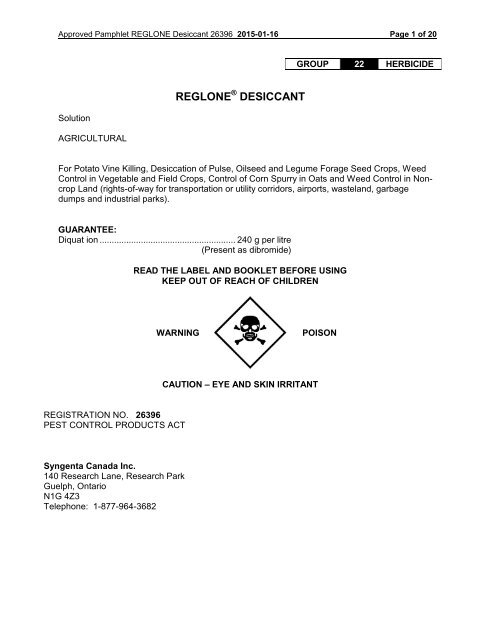
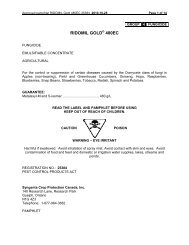
![gesagard 480sc [pamphlet] - Syngenta Crop Protection](https://img.yumpu.com/50945984/1/190x245/gesagard-480sc-pamphlet-syngenta-crop-protection.jpg?quality=85)
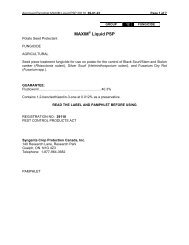
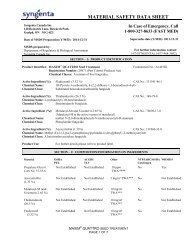
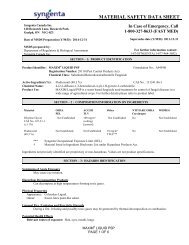
![ridomil Gold mz 68wp [bag] - Syngenta Farm](https://img.yumpu.com/49025229/1/190x245/ridomil-gold-mz-68wp-bag-syngenta-farm.jpg?quality=85)
